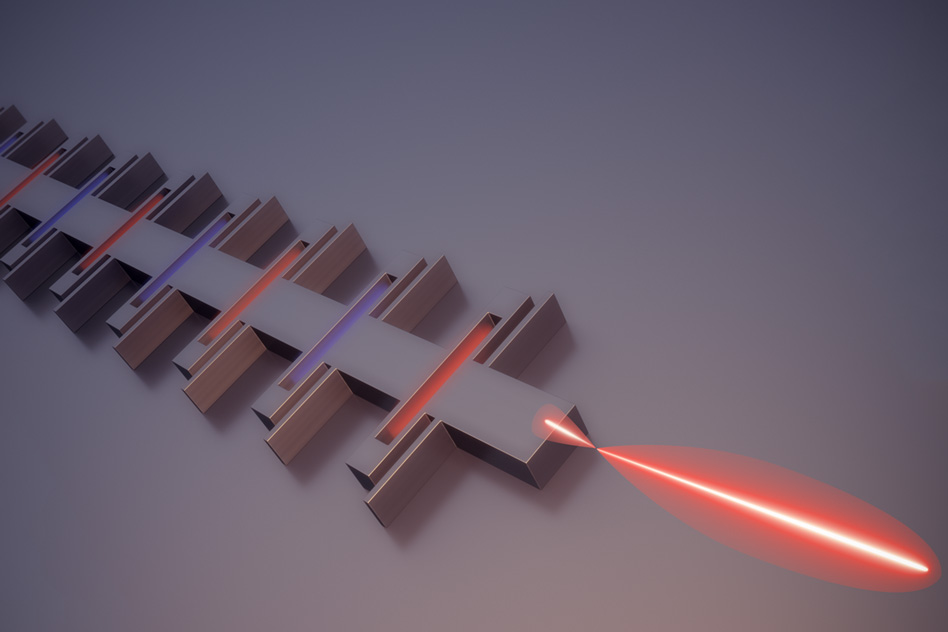Terahertz radiation, which lies between visible light and microwaves in the electromagnetic spectrum, has many potential applications in imaging and detection, but its use has been hampered by the size and power consumption of the equipment needed to generate it. Electrical engineers from MIT in Boston have now published details of a method to etch low-power terahertz lasers onto microchips.

Led by Prof Qing Hu, the method is the culmination of two decades of research. Published in Nature Photonics, the paper explains how Hu and colleagues from Sandia National Laboratory and the University of Toronto refined the design on a type of device called a quantum cascade those that with distributed feedback.
Their major discovery was how to overcome an inherent drawback of this type of laser: they emit light out of the front and back of the substance used to generate the laser, known as the gain medium.
Most terahertz applications require light in only one direction, so this property would normally waste half of the energy generated by the laser. In some types of device, it can be counted simply by placing a mirror on the end of the gain medium where the laser is not needed. This was not possible in this case, because the wavelength of light was so long in the laser itself so short that most of electromagnetic wave traversing the gain medium was travelling outside of the laser's body, so a mirror at the end would only reflect a very small fraction of the total energy.
The team's solution to this was to exploit a peculiarity of the laser’s design. Quantum cascade lasers consist of a waveguide; that is, a rectangular ridge of the gain medium flanked by oscillators that induce an electric field, which generates and propagates an electromagnetic wave travelling up and down the ridge. This is a standing wave, whose peaks and troughs reinforce each other so that if the wave were visualised it would appear to be static rather than travelling along the length of the waveguide.
Lead author on the paper Ali Khalatpour explains that the team cut regularly spaced slits into the sides of the waveguide to allow terahertz radiation to leak out sideways. The spacing of the slits is arranged so that the peaks of the escaping waves reinforce each other only along the axis of the waveguide; at oblique angles they cancel each other out.
Khalatpour and his colleagues then placed reflectors behind each of the holes in the waveguide. Sized to be wider than the ridge of the waveguide, these reflectors were again critically positioned, so that the energy they reflect reinforce the terahertz wave in one direction but cancel it out in all others.
Some of the energy escapes around the sides, but 80 per cent of the laser terahertz energy that would have escaped in the wrong direction is now redirected towards the correct end of the device.
The device has been selected by NASA, which co-funded the research, to provide terahertz emission for its Galactic/Extragalactic ULDB Spectroscopic Terahertz Observatory (GUSTO) mission.
Approved in March this year, GUSTO is designed to look at the composition of the interstellar medium: the material between the stars in the Milky Way galaxy and its associated cosmic structures, the Magellanic Clouds.
GUSTO will feature instruments mounted underneath long duration, high-altitude balloons on the upper atmosphere, and therefore low weight is crucial. Terahertz radiation is particularly useful for this mission, because it is uniquely well-suited for measuring concentrations of oxygen, believed to be an important element of the interstellar medium.
“GUSTO will provide the first complete study of all phases of the stellar life cycle, from the formation of molecular clouds, through star birth and evolution, to the formation of gas clouds and the re-initiation of the cycle,” said Paul Hertz, astrophysics division director in the Science Mission Directorate in Washington.
The mission is scheduled for 2021, and will be based at the McMurdo Science Station in the Antarctic.




Project to investigate hybrid approach to titanium manufacturing
What is this a hybrid of? Superplastic forming tends to be performed slowly as otherwise the behaviour is the hot creep that typifies hot...